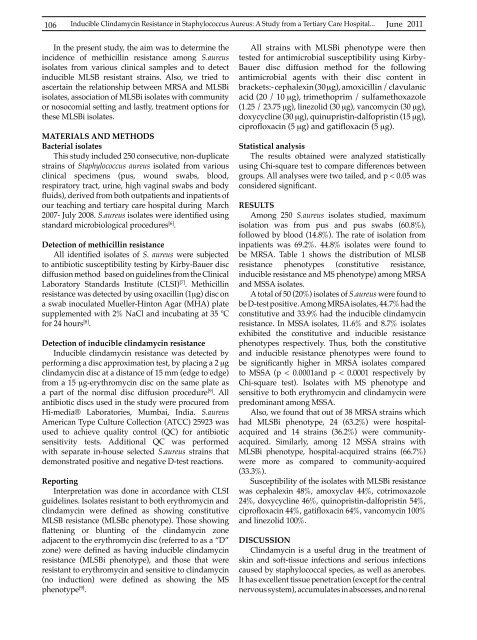Vol 43 # 2 June 2011 - Kma.org.kw
Vol 43 # 2 June 2011 - Kma.org.kw
Vol 43 # 2 June 2011 - Kma.org.kw
You also want an ePaper? Increase the reach of your titles
YUMPU automatically turns print PDFs into web optimized ePapers that Google loves.
106<br />
Inducible Clindamycin Resistance in Staphylococcus Aureus: A Study from a Tertiary Care Hospital...<br />
<strong>June</strong> <strong>2011</strong><br />
In the present study, the aim was to determine the<br />
incidence of methicillin resistance among S.aureus<br />
isolates from various clinical samples and to detect<br />
inducible MLSB resistant strains. Also, we tried to<br />
ascertain the relationship between MRSA and MLSBi<br />
isolates, association of MLSBi isolates with community<br />
or nosocomial setting and lastly, treatment options for<br />
these MLSBi isolates.<br />
MATERIALS AND METHODS<br />
Bacterial isolates<br />
This study included 250 consecutive, non-duplicate<br />
strains of Staphylococcus aureus isolated from various<br />
clinical specimens (pus, wound swabs, blood,<br />
respiratory tract, urine, high vaginal swabs and body<br />
fluids), derived from both outpatients and inpatients of<br />
our teaching and tertiary care hospital during March<br />
2007- July 2008. S.aureus isolates were identified using<br />
standard microbiological procedures [6] .<br />
Detection of methicillin resistance<br />
All identified isolates of S. aureus were subjected<br />
to antibiotic susceptibility testing by Kirby-Bauer disc<br />
diffusion method based on guidelines from the Clinical<br />
Laboratory Standards Institute (CLSI) [7] . Methicillin<br />
resistance was detected by using oxacillin (1μg) disc on<br />
a swab inoculated Mueller-Hinton Agar (MHA) plate<br />
supplemented with 2% NaCl and incubating at 35 ºC<br />
for 24 hours [8] .<br />
Detection of inducible clindamycin resistance<br />
Inducible clindamycin resistance was detected by<br />
performing a disc approximation test, by placing a 2 μg<br />
clindamycin disc at a distance of 15 mm (edge to edge)<br />
from a 15 μg-erythromycin disc on the same plate as<br />
a part of the normal disc diffusion procedure [9] . All<br />
antibiotic discs used in the study were procured from<br />
Hi-media® Laboratories, Mumbai, India. S.aureus<br />
American Type Culture Collection (ATCC) 25923 was<br />
used to achieve quality control (QC) for antibiotic<br />
sensitivity tests. Additional QC was performed<br />
with separate in-house selected S.aureus strains that<br />
demonstrated positive and negative D-test reactions.<br />
Reporting<br />
Interpretation was done in accordance with CLSI<br />
guidelines. Isolates resistant to both erythromycin and<br />
clindamycin were defined as showing constitutive<br />
MLSB resistance (MLSBc phenotype). Those showing<br />
flattening or blunting of the clindamycin zone<br />
adjacent to the erythromycin disc (referred to as a “D”<br />
zone) were defined as having inducible clindamycin<br />
resistance (MLSBi phenotype), and those that were<br />
resistant to erythromycin and sensitive to clindamycin<br />
(no induction) were defined as showing the MS<br />
phenotype [9] .<br />
All strains with MLSBi phenotype were then<br />
tested for antimicrobial susceptibility using Kirby-<br />
Bauer disc diffusion method for the following<br />
antimicrobial agents with their disc content in<br />
brackets:- cephalexin (30 μg), amoxicillin / clavulanic<br />
acid (20 / 10 μg), trimethoprim / sulfamethoxazole<br />
(1.25 / 23.75 μg), linezolid (30 μg), vancomycin (30 μg),<br />
doxycycline (30 μg), quinupristin-dalfopristin (15 μg),<br />
ciprofloxacin (5 μg) and gatifloxacin (5 μg).<br />
Statistical analysis<br />
The results obtained were analyzed statistically<br />
using Chi-square test to compare differences between<br />
groups. All analyses were two tailed, and p < 0.05 was<br />
considered significant.<br />
RESULTS<br />
Among 250 S.aureus isolates studied, maximum<br />
isolation was from pus and pus swabs (60.8%),<br />
followed by blood (14.8%). The rate of isolation from<br />
inpatients was 69.2%. 44.8% isolates were found to<br />
be MRSA. Table 1 shows the distribution of MLSB<br />
resistance phenotypes (constitutive resistance,<br />
inducible resistance and MS phenotype) among MRSA<br />
and MSSA isolates.<br />
A total of 50 (20%) isolates of S.aureus were found to<br />
be D-test positive. Among MRSA isolates, 44.7% had the<br />
constitutive and 33.9% had the inducible clindamycin<br />
resistance. In MSSA isolates, 11.6% and 8.7% isolates<br />
exhibited the constitutive and inducible resistance<br />
phenotypes respectively. Thus, both the constitutive<br />
and inducible resistance phenotypes were found to<br />
be significantly higher in MRSA isolates compared<br />
to MSSA (p < 0.0001and p < 0.0001 respectively by<br />
Chi-square test). Isolates with MS phenotype and<br />
sensitive to both erythromycin and clindamycin were<br />
predominant among MSSA.<br />
Also, we found that out of 38 MRSA strains which<br />
had MLSBi phenotype, 24 (63.2%) were hospitalacquired<br />
and 14 strains (36.2%) were communityacquired.<br />
Similarly, among 12 MSSA strains with<br />
MLSBi phenotype, hospital-acquired strains (66.7%)<br />
were more as compared to community-acquired<br />
(33.3%).<br />
Susceptibility of the isolates with MLSBi resistance<br />
was cephalexin 48%, amoxyclav 44%, cotrimoxazole<br />
24%, doxycycline 46%, quinopristin-dalfopristin 54%,<br />
ciprofloxacin 44%, gatifloxacin 64%, vancomycin 100%<br />
and linezolid 100%.<br />
DISCUSSION<br />
Clindamycin is a useful drug in the treatment of<br />
skin and soft-tissue infections and serious infections<br />
caused by staphylococcal species, as well as anerobes.<br />
It has excellent tissue penetration (except for the central<br />
nervous system), accumulates in abscesses, and no renal
















